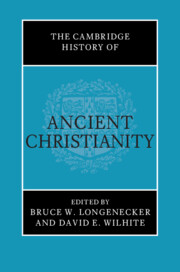Book contents
- The Cambridge History of Ancient Christianity
- The Cambridge History of Ancient Christianity
- Copyright page
- Contents
- Figures
- List of Contributors
- Editors’ Preface
- Part I Contested Contexts
- Part II Contested Figures
- Part III Contested Heritage
- Part IV Contested Cultures
- 14 Early Christians and Their Socioeconomic Contexts
- 15 Early Christians and Roman Imperial Ideology
- 16 Martyrdom between Fiction and Memory
- 17 The Emergence(s) of Christian Material Culture(s)
- 18 Manuscripts and the Making of the New Testament
- Part V Contested Beliefs
- Part VI Contested Bodies
- Ancient Sources
- Modern Authors
- References
17 - The Emergence(s) of Christian Material Culture(s)
from Part IV - Contested Cultures
Published online by Cambridge University Press: 23 August 2023
- The Cambridge History of Ancient Christianity
- The Cambridge History of Ancient Christianity
- Copyright page
- Contents
- Figures
- List of Contributors
- Editors’ Preface
- Part I Contested Contexts
- Part II Contested Figures
- Part III Contested Heritage
- Part IV Contested Cultures
- 14 Early Christians and Their Socioeconomic Contexts
- 15 Early Christians and Roman Imperial Ideology
- 16 Martyrdom between Fiction and Memory
- 17 The Emergence(s) of Christian Material Culture(s)
- 18 Manuscripts and the Making of the New Testament
- Part V Contested Beliefs
- Part VI Contested Bodies
- Ancient Sources
- Modern Authors
- References
Summary
Asking about the emergence of Christian material culture is something like asking when a river becomes a river. Countless drops of water fall on innumerable hillsides and plains, and make their way downhill, following the pull of gravity until they coalesce into rivulets and trickles. Those in turn gather into larger flows – streams, creeks, and washes – which combine and combine again into stronger and fuller courses. All the rivers of the world (the Nile, the Danube, the Congo, the Ganges, and the Yangtze, as well as the smaller and more anonymous ones) begin this way, fed by tributaries and histories of rain. When does the river become a river? We can point confidently to the mouth of the delta where the river empties out into the Gulf of Mexico and call that “the Mississippi,” but we must also recognize that its outflow represents a watershed draining a substantial part of a continent.
- Type
- Chapter
- Information
- The Cambridge History of Ancient Christianity , pp. 396 - 418Publisher: Cambridge University PressPrint publication year: 2023



